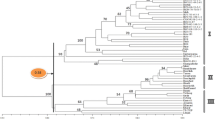Abstract
Genetic variation within and among five Danish populations of wild carrot and five cultivated varieties was investigated using amplified fragment length polymorphism (AFLP). Ten AFLP primer combinations produced 116 polymorphic bands. Based on the marker data an UPGMA-cluster analysis and principal component analysis (PCA) separated the Daucus collections into three groups, consisting of the wild populations, the old varieties, and the recently bred varieties. The genetic distance between the wild populations reflected the physical distance between collection sites. Analysis of genetic diversity showed that the old varieties released between 1974 and 1976 were more heterogeneous than the newly developed F1 hybrid varieties. The analysis of molecular variation (AMOVA) showed that the major part of the genetic variation in the plant material was found within populations/varieties. The presence of markers specific to the cultivated carrot makes it possible to detect introgression from cultivated to wild types.
Similar content being viewed by others
Author information
Authors and Affiliations
Additional information
Received: 6 October 1999 / Accepted: 4 November 1999
Rights and permissions
About this article
Cite this article
Shim, S., Jørgensen, R. Genetic structure in cultivated and wild carrots (Daucus carota L.) revealed by AFLP analysis. Theor Appl Genet 101, 227–233 (2000). https://doi.org/10.1007/s001220051473
Issue Date:
DOI: https://doi.org/10.1007/s001220051473




